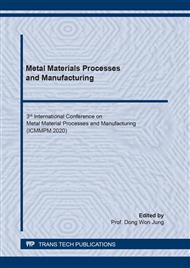p.65
p.71
p.79
p.85
p.91
p.97
p.105
p.111
p.117
Influence of Process Parameters on Material Removal Rate in Electrical Discharge Machining Cylindrical Shaped Parts
Abstract:
This paper aims to find the impact of Electric Discharge Machining (EDM) factors on material removal rate (MRR) for 90CrSi alloy steel. Five three-level factors including pulse on time (Ton), pulse off time (Toff), pulse current (IP), server voltage (SV), and diameter of work-piece (dw) are investigated to explore their contribution on MRR by using Taguchi method in twenty-seven experiments based on an orthogonal array L27 (35). The findings realize that MRR is the most affected by the pulse current while the effect of the dw is the smallest. Based on ANOVA analysis, an optimal model of MRR has been developed and verified by comparing with the experiment result. The applicability of this proposed method can be used for further studies in EDM process.
Info:
Periodical:
Pages:
91-95
Citation:
Online since:
January 2021
Keywords:
Price:
Сopyright:
© 2021 Trans Tech Publications Ltd. All Rights Reserved
Share:
Citation:


